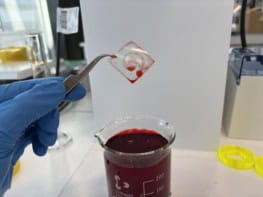
Researchers at Cardiff University in the UK have joined forces with the helmet-maker Charles Owen Inc. to develop a new material that could protect against a range of head injuries. Dubbed “C3“, the multilayered material can either be 3D printed to create bespoke helmets for professional athletes or injection moulded to create lower-cost consumer goods. The collaboration is being funded to the tune of $250,000 by the US-based Head Health Initiative to develop manufacturing and computer-simulation technology that could make commercialization of the material possible.
Helmets are ubiquitous – and often mandatory – in a wide range of activities from skiing to American football. They do a pretty good job of protecting the wearer from compression impacts in which the force of impact is directed towards the centre of the brain. Helmets are not very good, however, at absorbing the twisting forces that occur when the head suffers a glancing blow that causes it to rotate. Large twists of the head can cause the brain to rotate relative to the skull, damaging the blood vessels that supply the brain and so leading to serious injury.
“Strategies for the prevention of head injuries have remained relatively stagnant versus the evolution of other technologies,” explains Peter Theobald of Cardiff University, who leads the C3 development project along with Roy Burek of Charles Owen.
Explosive inspiration
The material was inspired by explosion-resistant materials created by Graham McShane and colleagues at the University of Cambridge in the UK. McShane’s team was developing materials for the military that are lightweight but also capable of absorbing huge amounts of energy from blasts. The idea the researchers hit upon employs origami-inspired steel structures that collapse by folding in a controlled manner to absorb blast energy.
Theobald and McShane realized that similar structures could be made from polymer-based materials. Furthermore, the folding parameters of the structures could be “tuned” to absorb different types of forces. Theobald explains that it should be possible to develop a layered structure in which one layer is good at absorbing compression impacts while the other is good at absorbing shear.
Described by McShane as a “highly designed foam”, the material comprises arrow-shaped elements that are packed together in layers (see image). A material with specific properties can be designed using mathematical modelling and its performance simulated using high-performance computing. 3D printing is then used to create a prototype that can be tested in the lab. While 3D printing could be used to create bespoke helmets for professional athletes, Theobald says that helmets could also be mass-produced using injection moulding.
The grant will allow the collaboration to spend one year improving the manufacturability of C3, as well as its response to compression and shear forces. The Head Health Initiative is funded by General Electric, the National Football League, the sportswear manufacturer Under Armour and the National Institute of Standards and Technology. It is making up to $20m available to scientists working towards the understanding and prevention of brain injuries.
Deployable protection
Theobald hopes that the new material will encourage manufacturers and standards bodies to focus on improving the ability of helmets to protect from shear forces. McShane says that other applications of origami-inspired materials include car bumpers and “deployable protection” devices that could quickly unfold upon impact, much like a vehicle’s airbag.



